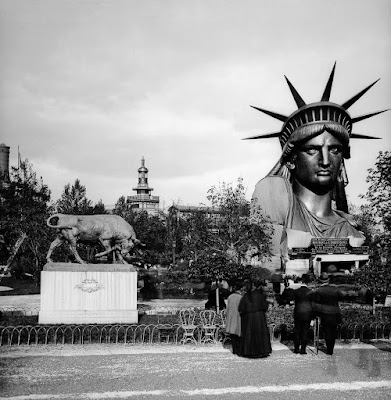
1878 - The Head of The Statue of Liberty at the Paris World Fair
In the early 1870s, inspired by the abolition of slavery and the Union victory in the American Civil War, French sculptor Frédéric Auguste Bartholdi seized upon an idea.
He would build a monumental gift for the United States, a gesture of friendship from a country that had helped secure its independence.
When Bartholdi visited the United States to gather support for the project, he identified Bedloe’s Island in New York Harbor as the ideal site.
It was right at the mouth of a major port, and was federally owned “land common to all the states.”
The neoclassical statue was designed in the image of Libertas, the Roman goddess of freedom, raising a torch and bearing a tabula ansata, representing law.
 |
| Hand and Torch of Statue on display in 1875 at the Centennial Exposition in Philadelphia |
 |
| Head of Statue on display at Paris World Fair 1878 |
Bartholdi toyed with the idea of having the statue hold a broken chain, but feared such an explicit reference to slavery might be controversial. (The final statue does have a subtle chain at her feet.)
In 1875, the project was announced and fundraising began, led by French politician Édouard René de Laboulaye. Before the statue’s design had been finalized, Bartholdi built the head and torch-bearing right arm and put them on display at the Centennial Exposition in Philadelphia and the Paris World’s Fair to drum up support for the project.
Construction began in Paris in 1877. Bartholdi recruited renowned designer Gustave Eiffel to help with the structural engineering of the statue.
Eiffel devised an innovative and flexible iron skeleton which would allow the statue to shift in the wind without cracking.
Meanwhile in New York, construction of the statue's pedestal was sluggish due to a lack of funds. Joseph Pulitzer, publisher of the New York World, held a fundraising drive, promising to publish the names of everyone who donated.
The fund ultimately raised $102,000, mostly from donations of less than a dollar.
In 1885, the statue was disassembled and shipped across the ocean to New York.
Once the pedestal was completed in April 1886, the statue was reassembled by workers dangling from ropes.
Surprisingly (given the safety standards of the time), not a single worker died.
The statue, formally called Liberty Enlightening the World, was ceremonially dedicated on Oct. 28, 1886.
The monument’s signature green color, caused by the oxidization of the copper skin, did not emerge until after 1900.
Source Alex Q. Arbuckle
 |
Illustration of the unveiling of the Statue in Paris to the US Ambassador to France in 1885
|
No comments:
Post a Comment